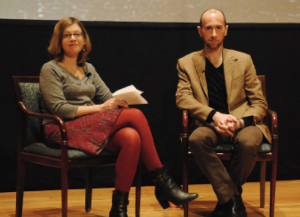Speaking on the topic of gender stereotypes that exist in our society today and the role it plays in the performance and ballet industry were history professor Cynthia Paces and owner of Renaissance Dance in Ewing, Bernd Burgmaier.

Burgmaier, who has been a ballet dancer almost all his life, provided insight on his experience as a male in a stereotypical female gender role.
When asked how he first realized he wanted to pursue dance, Burgmaier explained that he knew from a young age.
However, because he grew up in a small village in Germany, it was perceived as “odd” that a boy wanted to practice ballet.
He recalled waiting to speak to his first dance teacher with his mother.
When they only saw girls exit the studio, his mother leaned over to him and said, “We can still leave, it’s just girls.”
But Burgmaier explained to the audience how it did not bother him that it was thought of as a female sport and said, “For me, it’s the joy of dancing.”
After rigorous ballet training, he was one of 35 dancers chosen for an international dance team out of the 600 dancers from all over Europe.
Burgmaier went on to explain one of the first things he learned from ballet discipline. His teachers were strict and he would leave classes bruised from the intensity of practice.
The girls, he said, practiced the “sensitive, fragile side of it,” while the boys practiced “the athletic side of it.”
After six years of dancing and performing, Burgmaier decided he needed a break from the disciplined world of ballet and joined a modern dance program in Munich, Germany.
“It was very freeing,” he said, “I could go to class without being afraid.”
Burgmaier’s switch to modern dance led him to taking a class in New York at Merce Cunningham.
He described the difference between the two types of dance, referring to modern dance as “very physical, no emotion.”
Later, Burgmaier joined the Les Ballets Trockadero, a group of men from New York who perform ballet dances, which are meant to be comical.
He explained that the purpose of the spoof performances was for “men to dance as a man in a woman’s costume.”
The message behind the Trock’s performances could be related to a statement made by Judith Butler, an author on gender roles, explained Paces.
Butler discusses the difference between the biology of gender and the culture of gender. She said, “There is no gender identity behind the expression of gender.”
Burgmaier, himself, took on the role of female, performing a famous solo, “The Dying Swan,” originally performed by German ballerina, Anna Pavalova.
Overall, Pace’s interview with Burgmaier allowed for an open discussion on gender roles in ballet and depicted the masculine side of dancing that is typically not seen.
In reaction to Burgmaier’s performance, Jen D’Elia, freshman arts and communication studies open options major, said, “In his performance he was perceived as a girl, but people seemed to enjoy it.”






